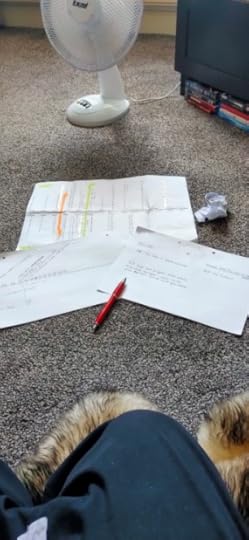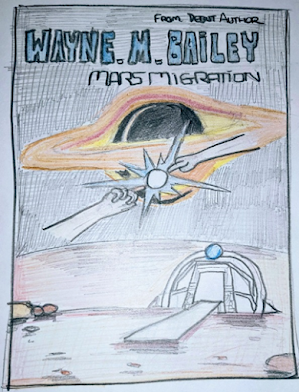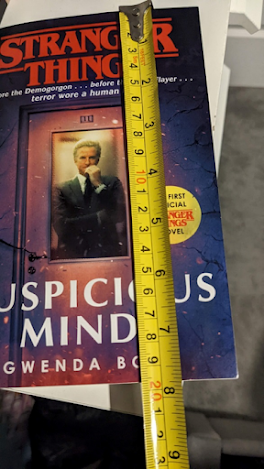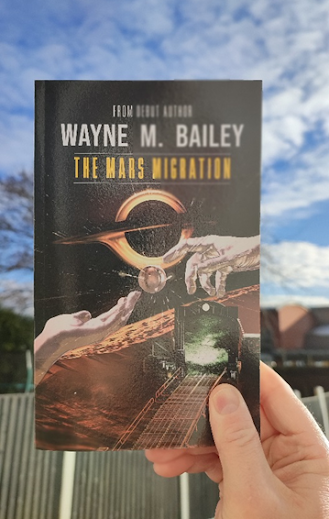The nuts and bolts of my writing journey.
Hi you! Me again. This is going to be a long one, so getcomfy. I thought I would run through some of the stages I went through in mywriting, giving you a full nuts and bolts account of the things that we gothrough in our first books publishing journey.
Hopefully this might help you a little if you are just startingyour own writing journey. Or you may just be interested in reading more aboutmy own journey, either way, here it is and thank you for reading it.
So, my previous blog about the UFO sightings might have givenyou a little insight on some of my influences for the actual story. But whatabout the work that goes into making the book? All the behind the scenes stuff.How did I start off? How did I publish it? How did I get a book on Amazon, andon the shelves at Waterstones stores?
I will try and answer some of those questions here.
So, once I had the idea that I wanted to write something,and I started to get ideas flowing for my story, rather than plan and plot (tostart with anyway), I just started to type. Google Docs was what worked for me,for these main reasons - I could start the book on my laptop, signed into my Googleaccount at home, and then if I was at work on my lunchbreak I could log on andcarry on with it.
Also, and very importantly - Google Docs saves your work asyou go, so no risk of losing your progress really. I have heard about someauthors that have used Word, and not clicked save when exiting. Or their laptophas had a meltdown and they’ve lost everything. Google Docs instantly saves asyou go.
I did find one disadvantage much later on in the process ofusing Google Docs over MS Word. I’ll go into that later and how we fixed it.
So anyway, you type out your story, they say to stick to 12size text, double spaced, and Times new Roman, it’s like the industry standard.You write your story and then type “The end.”
Now, not to get too excited here, the work is far fromnearly over. At this stage, I would recommend your first step is finding some“Beta readers.” You can start with people that you know, who love to read, and hopethat they give you some constructive criticism of your story and writing.
I’ll be blunt here, sorry if I offend anyone, but it’s true,family and friends are lovely to have, you will need them for support, but honestly,they don’t make the best beta readers. Why? Because they don’t want to hurtyour feelings.
You need someone who will be blunt with you, and honestly –if your writing or story is shite – to tell you so, nicely if possible.
I wrote out my first draft, and then googled “beta readers,”and made a notes of a few to email. These are people that I didn’t know, they’rethe best Beta readers. They will have websites hopefully explaining that they willdo beta reads of your story. Some charge, but I managed to find a few readersthat offer to read your book for free.
So, I sent off my first draft to three Beta readers, bearingin mind that I had already been working on my story for just over a year.Prepare yourself that you may possibly get hurt here. Out of the three, oneagreed to read the whole story. One read the first chapter and kindly let meknow that she would leave it there, and one just refused it point blank.
The one that very kindly read the whole draft, produced forme a very good report – what worked, what didn’t, what it lacked story wise,where it was slow, or needed further explanation. Also that I was switchingtenses and viewpoints. When I started, I didn’t even know what this meant. Sheexplained that I had the makings of a story, but it was not a story yet.
Obviously depending on your internal make-up, you are eithergoing to cry like a baby, or get straight back to it.
I was shaken at first, I won’t lie, but then I went straightback into it. Looking back, my writing was shite!
I completely re-wrote it. Not simply editing my first draft,I took my basic plot across, and started again on a new file. I probably spentanother year re-writing it. This time, with more note making of where I wanteda chapter to go, I made diagrams of the different timelines and time zones. Iworked on making it more dramatic and with more twists.
 Working out my timelines
Working out my timelines
To help me to write a proper book this time, I startedreading a lot more. I read books at work, in the bath, in bed, listened toaudio books while commuting, I read, read and read. I’ll admit to not beingmuch of a reader before this journey started – and I think the best advice Ihad was read read read. I think this is very important!
Now, a lot more work went into my writing, a lot of sleeplessnight thinking of plot holes, even in the middle of the night - I finally endedup with my second draft. But even still, in the weeks after thinking I wasfinished, I would still keep going back into the book, and I would add thingsand take things out. It’s funny the things that come to you while you’re justdriving about, at work, or in bed.
 Making notes wherever I can.
Making notes wherever I can.Stephen King would recommend that you now put it in a drawand let it rest for a while. Which I did, or I tried to do. His book “OnWriting” is very much worth a read.
Once you feel like you are definitely done writing, to thepoint where you can’t think of anything else to change, then it’s time to startdeciding on which way we are going with the publishing. Are we self-publishing,or are we going for the apparent big money traditional publishing?
I can’t speak for every detail on either side of thepublishing journey, but this is what I made of it:
If you self-publish your book, you are paying for, anddesigning every step of the book yourself. You are fully producing it and havefull control over it. You are publishing it and marketing it yourself, frombeginning to end. You will then get royalty payments from every copy sold, whereveryou decide to publish it.
If you go for traditional publishing, you would spend timequerying for agents, you will then have some input, and then from what I gatherthe publisher will give you a nice big cheque, to pay you for your book – if itis up to a certain standard of course. They will get it edited and the coverdone for you. They will publish it and market it for you, sending you royaltycheque’s every month.
If you want to go for traditional publishing, “to query fora publisher”, you would start to send your manuscript off to agents first. Hopefullyone will agree to work with you. You will get rejections, lots of them. Butthen if they sign you up, they will pitch it to the publishers on your behalf,aiming to get you, and them, the best deal possible.
I wasn’t patient enough for that, I had spent three yearsworking on it, I was ready to go for it, now! So, I dived right into theself-publishing route.
I started shopping around for the services that I knew I wasgoing to need others for – What would be the most expensive parts of thejourney. These are cover design, and editing.
Some people will tell you … “Oh you can publish a book forfree on Amazon.” Yes, you could, but it would be rubbish - In my humble opinion.
Let’s start with the cover. Only because it’s worth startingto gather ideas for what you want on it as early as you can and get a feel for howyou want it to look. At this point, you will either know exactly what you want,or you won’t have a Scooby-Doo! I had already made some rough sketches at thisstage, I had an idea of what I wanted on it. I had been scouring vintagescience fiction books like Arthur C. Clarke and Asimov, so that’s the kind offeels I wanted for mine.
 My rough arse cover sketch.
My rough arse cover sketch.
So then I started to shop around on Google and Fiverr forcover designers and artists. I saved a few of them to my browser bookmarksuntil I had decided.
The thing I would say with cover designers is – you must doyour diligence, use common sense. Check that they have lots of reviews, examplesof their work, and ask yourself if the reviews look genuine? If they’re onFiverr, do they have a professional looking website of their own as well? Remember,cheap does not always mean good and proper.
One thing horror story that I read about some cheap coverdesigners - which scared me - is that there are some people who claim to be acover designer. They might make a nice job of it, but some have been known touse stock images. Images that may have been used on other covers, or maybe evenbelong to somebody else. Ask whoever you use, “are these images that you are usingproperly licenced?” If they have just took them off the internet, or someoneelse’s website, you may well get emails from people trying to sue you for usingtheir images or covers. So you have to be very careful and check that the coverdesigner is experienced and pays for the rights to use the images that theyuse.
In the end I didn’t use Fiverr for this, I googled bookcover designers again and came across Flintlock covers, who took my rough arsesketch, and turned it into a pucka design. It wasn’t cheap (compared to Fiverr),but I was happy knowing that it would be quality, and all licenced and correct.
I also noticed on Shaun’s website that he would size theimages correctly for Amazon and Ingramspark (more on those later too). So thatI wouldn’t have any trouble when uploading my files to wherever I wanted topublish my book. You do see a lot of questions from people in Facebook writer’sgroups asking why Amazon keeps rejecting their cover images. It’s likely thatthey have designed it themselves, or used an inexperienced designer, and theyare not the correct the correct sizes.
Next, I started the search for editors. Again I started off lookingon Fiverr to get some ideas of what I was looking to pay out. Editing and thecover will be by far your biggest outlays!
I started saving editors that looked good to me onto my browserbookmarks again.
The thing with editing, is that you could spend well intothe thousands on this. Again there are people claiming to be editors, but youmight want to contact a couple and ask for an idea on cost, and what theirqualifications are, Fiverr is useful, as it generally tells you the cost basedon your word count. There are some genuinely talented people on there, I’m notknocking it at all. My editor was actually on Fiverr, I just checked that shehad her own website as well, so I could see who I was dealing with.
Now, something that I had to learn, and you will come tolearn, is that there are different types of edit that you need to have done, hereare a few of the main types:
Developmental editing– this looks at things like the structure and plot, viewpoints and narrativestyles, thing like that.
Line edit – thislooks at word choices, whether the dialogue makes sense, clichés used,past/present tenses and if you have used them correctly.
Copy editing –things like spelling, grammar, letter & line spacing, dialogue tagging,hyphenation, capitalisation.
I know, bit scary and complicated, isn’t it?
Each of these rounds of edit will cost you. I read about,and then went on the journey myself, of trying to find an editor that would doan all-in-one package, they are out there. It just takes some searching.
Budget wise, like I say they can range from around £500 upto a few thousand easily! So - especially for your first try at doing a book -it is all about finding one that is suitable for your budget. The best you canfind, compared to what you can afford. They mostly give you a price based onword count. Most writing programs will tell you the word count at the bottom ofthe screen.
I found one that I liked the look of – I was attracted by anaffordable price, she had her own proofreading website, and that she says thatshe is a self-confessed “SCI-FI Nut” - Winner! Cleo Miele from Texas was thechosen one for my editing.
We’re still going for a while yet, sorry. Go and do yourselfa cuppa. Much still to do yet.
With my story completed, I sent it off to her to begin her editing.After a few weeks, I started to get emails asking what something meant. Thereis one section in my story, where I had gone into some local Black Countrydialect, which was funny and really threw her. We had some laughs about the waythe British, and the Americans use different words for things.
After a while I had my book back, with all of the editsshown to me on the screen, with notes down the right-hand side. I could eitherapply all of her changes in one go, or go through each one, approving herchanges or keeping it as my version. This was quite another long process. It’stough because you think you are at the end of it.
Ok, here is where I will say that Google Docs falls down.For some reason, I think maybe by now, the size of the file with all the editson as well, was just too big for a web browser to cope with.
I could not open my book with all the edits on. Browserswould just crash. Luckily, very luckily, Cleo had a copy of it that she couldsend me on MS Word with the tracked changes on – Day saved! (Thank you, Cleo, 😊)
Once I had made all the changes that I wanted - on Word, Isent it back to Cleo, and then she goes through it again, (included in herquoted cost). To make sure that any changes I have made, are stillgrammatically correct and make sense. It wasn’t just grammar - I had made a fewchanges to the story too, Cleo would give me her input on scenes, which wasinvaluable!
Editing complete. Phew!
Now we go back to cover guy Shaun, I needed my bookformatted next. Otherwise known as Typesetting. This will make our edited andfinal word file, look like a book.
It will be laid out properly according to your chosenphysical book size, yes, you have to choose a book size too. Each genre of bookwill have a recommended physical size, so google what is recommended for yourgenre…
 Measuring books to get an idea on what size to go for.
Measuring books to get an idea on what size to go for.
If your cover person is worth their salt, they will alsohelp you with this. As Shaun did. You might want dropped fancy capitals at thebeginning of a paragraph, things like that to add a bit of style to the words.You will end up with the correct file types from your formatter – PDF, ePUB,MOBI are some of the file types that you will need to upload to amazon forkindle and ingramspark for print books.
I noticed on Shaun’s website that he offered formatting aswell as covers, again, a bit dearer than someone on Fiverr would charge, but Iliked the thought of keeping it in house with someone who knew what he wasdoing. If I had any issues in the future, I knew that Shaun will help me.
So I placed an order with Shaun for the formatting as wellas approving the final cover design.
Now we almost have a book. We have the edited file, typesetand a shiny cover.
Now to look into actually publishing it.
I knew I wanted to end up with a paperback and ebookversions of my book, so naturally I started thinking about Amazon. They havethe biggest market share, so it makes sense to start there.
Now, here is an important thing to be considered, andanother purchase you have to make, sorry! ISBN numbers. You will need one ISBNnumber for each format of your book. So for example, you will need one forebook, one for paperback, one for hardback and one for audiobook if you so wishto have them. This ISBN number is the long number on the back of every book,what the world database of books knows you by. It makes each book easilytrackable for the bookshops, libraries, and everyone who deals in books,searches for this number.
If you are going to be self-publishing, and in all of thosedifferent formats, and likely doing another book, it is better for you to them buyin bulk. They get cheaper the more you buy, if you can afford to buy in blocksof 10, or more this is better.
Each country of the world has its own official agency thatsells you the ISBN numbers. So for the USA its Bowkers who will charge you $125for one, or a block of 10 for £295 – See what I mean?
In the UK its Nielsen BookData. £91 for one ISBN, or £169for 10.
So whichever country you are in, just google where to buyISBN’s in your country.
A couple of extra points I want to make on ISBN’s before Imove on. And something that affected where I brought mine from, and who showsup as the publisher.
Very importantly, some people will tell you – “You don’tneed to buy an ISBN number, as when you publish on Amazon, if you don’t haveone, one will be supplied to you by Amazon.” Yep, but then you can’t publishyour book anywhere else aside from Amazon, if you have dreams about gettingyour book in bookshops – forget about Amazon’s free ISBN number!
That’s why it is important to sort your own out, and thenwhen you publish to Amazon, you tell it that you have your own ISBN, thank youvery much!
I didn’t buy mine from Nielsen BookData – and I’ll explainwhy. I had a thought, and then found a bit of a work around for that thought.
If you are self-publishing, and you buy your own ISBN numberdirect from the agency for your country, if a bookshop searches for your ISBN,it will tell them that you“Dave” are the Books publisher. I personally think that this could cost you alittle cred when that happens. I could be wrong – that is just my impression –I imagine the bookshop owner looking at newly published books for that month onthe book release catalogue, wondering what to stock …
“Shall we stock this one Fred?”
“Who is the publisher?”
“Dave!”
So, here is another way. While searching for ISBN numbersonline, I came across Compass-Publishing UK, and Alexa there sells ISBN numbersfrom her publishing house. Cheaper than you can buy a single one from Nielsen’s– she obviously buys in bulk being a small publishing house.
If you buy your ISBN from Alexa, and publish using thatnumber, when a bookshop now searches for that ISBN number – the publisher willshow up as “Compass-Publishing UK” – It adds a little more cred points doesn’tit? Do you agree?
You now have a self-published book, but it also now lookslike you have been traditionally published by Compass-Publishing UK! Result!
That’s what I did. You still get to keep all your rights andyour profits too.
Now, to start the ball rolling on hitting that publishbutton, to make it public, all you do is open an account on Amazon KDP, andupload the files, it pretty much walks you through everything step by step. Youupload the cover, you upload the files that your formatter sent you, you set aprice, but don’t click publish just yet. It lets you save as a draft. Do that,and again I’ll explain why below.
Ok, so you have your files waiting to go on KDP, saved as adraft, all you have to do is smack that publish now button, and you are live. Don’thit it just yet.
So, Amazon KDP will get us our paperback, and an ebook forkindle. But what bookshop or library is going to order your book from Amazon?None!
You will likely, like I did want to “Go wide” to get yourbook into as many places as possible – not just on Amazon, so you need anotheroption for publishing that will get you the trade contacts, the bookshops, thelibraries. So this is why we will also create an account on, and upload ourfiles in the same way as on Amazon, but on Ingramspark.
Ingramspark will get you the chance to get into bookshops,as for example Bookshop.org/Bookshop.UK/Waterstones and I think, but not 100%on this - Barnes & Noble, all order through a book wholesale system calledGardners Books. And Gardeners order from Ingramspark – who are a book printerand distributor.
There is a small charge to upload your files to Ingramspark,but sometimes they do introductory offers. But you still need to do it if youwant to sell in more places than just Amazon. So even if you have to pay, itsworth it.
Ok, in the interest of transparency, here is a stage where Ireally cocked up, Big stylie!
I want to explain what I did, so that you don’t have to cockup, or it might help you handle this part a little better than I did.
Your sell price, my thinking here was that I would keep mycover price as low as possible, so that people could afford it, and that Iwould hopefully sell more copies. Nobody knows who the hell I am, so who isgoing to want to spend more money on your book than say, Stephen King’s book?
I was set in my head that my book was going to be £9.99.Sounds fair right? So I told Shaun the cover guy, to print on the back by thebarcode that my book is going to be £9.99.
Shaun said, I wouldn’t put the price on the back if I wereyou.
Now, I had read that bookshops prefer a price on the back,so that’s what I wanted dammit!
Anyway, I can’t remember what the actual figures were here,but when you upload your files to Amazon and Ingram, which I was now doingafter having £9.99 on my cover and approving it.
Amazon and Ingram take into account printing and handlingcosts, and have a wonderful calculator on there that now tells you what yourroyalty from each book sold will be. I would be making a minus figure from eachbook sold! Whoops!
So now I needed to go back to Shaun, and say, sorry MrShaun, you know how I demanded a price on the back, and you told me not to, Ineed it changing now please. He had to charge me for the changes to the files.Bugger and Feck!
Anyway, sorted, £12.99 is my cover price now. For threeyears of work, and a fortune spent, I would like to have at least some moneycoming back in.
So to continue on with the publishing. I have my files onAmazon KDP, saved to a draft for kindle and paperback.
The same on Ingramspark, saved to draft waiting to go. Ichoose a publish date and set it, and away we go.
Now, this is why you don’t hit publish yet on Amazon, forsome unknown mystifying reason, Amazon will allow you to upload your bookfiles, and set a release date for your ebook. Say you’re in July, and want itto release on August 20th, Amazon will let you do that for your ebook. But notfor your paperback! I know right, weird as hell.
Ingamspark will allow you to set a release date in thefuture, it’s just the Amazon paperback part that won’t. I don’t get it.
So, once you hit publish on your Amazon paperback, it islive. So I found that the best way to handle this, is with Amazon and ingramboth having your files saved as a draft ready to go, set Ingramspark to releaseon August 20th, your kindle book to release on August 20th,and hit publish on your Amazon paperback the day before, so on August 19th.
There is another option that I dabbled with for publishingyour ebook wider – Draft2Digital. This website if you upload your book to it,gets your ebook onto more marketplaces – so you will get on Apple Books, Kobo,Scribd, Smashwords, Vivlio, Barnes & Noble and a few more sites. It willliterally get your ebook around the world. It doesn’t cost you anything, butobviously they take a percentage of your royalties. If you do try this, justremember to untick that you want Draft2Digital to list your book on Kindle, itwill already be on there.
Personally, I did try Draft2Digital for the first few monthsafter my release, but to be honest I sold barely a few books that’s all, Amazonis by FAR the market leader. It does make you appreciate how much market share theyhave in the book world.
So, after a few months of being live, I decided to tryputting my book on Kindle Unlimited, which I didn’t do to begin with, as this meanspulling your book off Draft2Digital. Amazon must have exclusivity if you go onKU – only for ebooks though. You can still sell your paperback on as manyplaces as you wish.
I have had some joy with Kindle Unlimited, people arereading my book – Thank you, if that is you! As of the end of April 2023 Justover 4000 pages have been read. And I made it available on KU in January, so thatis in just three months.
Basically, how that works is you get paid per page read,from the Kindle Unlimited world fund. So you do still get royalties. Althoughsome of its appeal is also gaining new readers.
Remember - Kindle Unlimited readers, read that much that theypay for the privilege every month. So in my opinion it is worth being on there.
When you have got to your chosen date, and the books becamelive, you will be checking every hour of every day to see how many have sold.
Being self-published, well, kind of… (With my little workaround) You’re not talking big numbers, that’s why every single sale means theworld! You can go long periods where you haven’t sold any at all, so it isimportant to dabble in some paid ads, Amazon and Facebook are the ones I haveused, with varying results. But if you don’t try any, you ill just disappearoff the page.
 My finished book.
My finished book.Now you have to get your head around marketing. This is adifferent story for a different day!
If you are going through the same as what I have been, Isincerely wish you the best of luck.
Thank you so much for taking the time to read my madramblings again!
And thank you to everyone that has read my book, I honestlyappreciate you so much!
Please remember to review if you have read it, this canreally help me.
Thank you so, so much!
Wayne.



